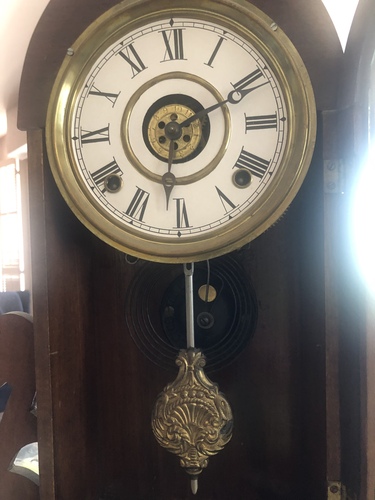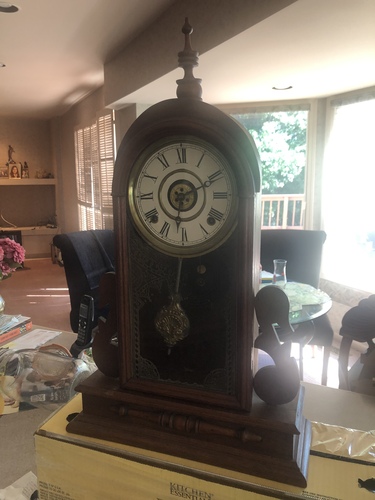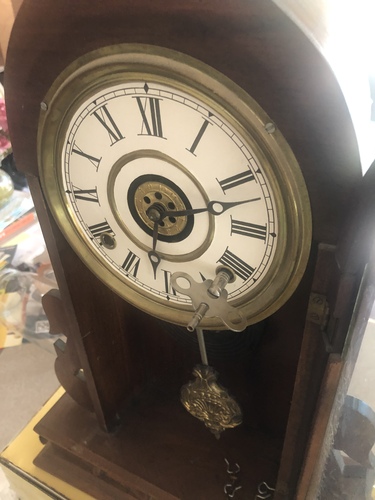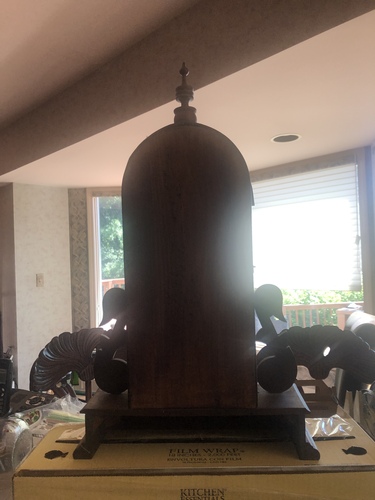Clock sits in case 7” wide by 15 inches tall. Has a base and carvings.
I remember my mom seeing in antique shop in Caseville, Michigan. She talked with owner about it. Was supposed to be antique. I see no markings on top, bottom or on click face, pendulum etc.


Hello Gina,
Thank you for sending in this mantel clock to mearto.com for an appraisal. Some antique clocks are most difficult to diagnose accurately once they have passed through an antique dealer’s hands, although I think the dealer, in this case bought it, as is, to sell.
TITLE:
Reconstructed, walnut, dual steel springs, eight-day time and hour and half hour Cathedral gong striking parlor mantel clock with alarm, unsigned on dial and missing a label (also movement not shown), attributed to the Ingraham Clock Company, Bristol Connecticut as a version of their original Parisian model (see the Tran Duy Ly text, Ingraham Clocks and Watches, page 277, figure 886). The Parisian clock first appeared in the Ingraham catalog in 1884.
PROVENANCE:
Inherited : I remember my mom seeing in antique shop in Caseville, Michigan. She talked with owner about it. Was supposed to be antique. I see no markings on top, bottom or on click face, pendulum etc.
DESCRIPTION:
CASE: Currently measures 15” x 7” (original case was 25” tall). Originally, this clock case had a broad dome shaped pediment which continued around the top of the clock and ended adjacent to the figures three and nine on the dial. It had large carved teardrop wooden finials extending down to the level of the middle of the case. In the center of the top of the dome was a large keystone with a female neo-classical goddess head on the facade of the keystone with a cap on top the keystone holding a bulbous carved finial with a long spire on top. All of that pediment has been removed from the clock, likely because of damage to it at some point leaving only the plain frieze underneath the pediment which has been tapered and cut off at the level of three and nine positions giving the clock a dome like appearance. A bulbous or vasiform finial with triple ring turnings has been placed atop the dome. Below the remains of the pediment is the dome shaped door rails with a ring turning at the three and nine positions, glazed and domed at the top and squared at the base of the door. A yellowed foliate decal is present on the inside of the lower glass in the door. There are two sidearms which mimic those found on the genuine Parisian clock case but I suspect that these were made by whoever altered the form of the clock, a local wood crafter of some type because he leaves off the decorations carved into the upper and lower rounded sections. The door rail itself that surrounds the glazed door is built in the form of a column all the way round the glass. The base is a replica of the original Parisian model clock with a horizontal frieze bearing an applied half column of ringed and turned carved walnut ornament that runs horizontally and below there is a double moulding, the upper one concave, the lowest convex with flat base without feet sitting flat to the surface.
Dial: This is a two-part dial made of paper with a black Roman hour chapter ring to the outside with closed bar minute track, two winding apertures for winding the two springs in the movement, and then a brass ring separates the hours from the dial center which has a brass alarm ring with Arabic hours (1-12). If one wanted to wake at seven AM, you rotate the brass ring until the 7 lies directly under the current position of the hour hand (wherever it is), a separate winding spring should be found in the base of the clock which is then wound, and when the hour hand next reaches the seven position the alarm will be set off. (I do not see that alarm spring in the bottom of the case and I assume the alarm cannot function.). The dial has steel antique Breguet hands as did the Parisian model. I feel the paper dial has been replaced since it shows no signs of age.
MOVEMENT: Not shown. Usually this would be a fenestrated brass plate movement signed by the clockmaking company. However, since it is not shown, I cannot be of assistance in helping to pin down the maker.
INGRAHAM CLOCK COMPANY HISTORY:
Elias Ingraham (1805-1885) made his name in Bristol Connecticut during the years 1828-1830+ as a case maker. He designed the carved case American wooden works shelf clock. He aided in the design of the steeple and beehive clocks of the 1840's. In the age of factory manufacturing starting about 1850 he built his company into one of the great Connecticut Clock factories, comparable to Seth Thomas and the New Haven Company. It survived until 1967.
Elias Ingraham and his brother Andrew founded this business. From 1852-1855 it was called E & A Ingraham. From 1857-60 it was Elias Ingraham & Company. 1861-1880 the name was E. Ingraham & Company. 1880-1884=The E. Ingraham & Company. It became the E. Ingraham Company from 1884-1958.
PRICING/COMMENTARY:
The Ingraham Parisian sold for $450at auction 1999 and had dropped to $225 by 2011 and has lost more value when in good condition since then. See: https://www.liveauctioneers.com/item/9538210_245-ingraham-parisian-parlor-clock ………………………………………..
Your clock has been devalued by whoever owned it prior to the antique dealer buying it for his shop. It has lost most of its value from the cutting down of parts and making of other parts and is most likely a handcrafter’s home project. The paper dial is replaced and shows no signs of wear. This is definitely an American made clock, likely made by Ingraham in the mid-1880s and then was deconstructed to a simpler form by its owner. It has a nice clean look to it but it is really meant for a decorator or home furnishings person to buy for next to nothing and sell to a client for something higher than that. It is not a genuine true antique clock as it has been “restored” it has become something "other than it was meant to be". I am truly sorry I have to bring this sad news to you about the family clock, but this happens all the time. The door and glass are all original as is the pendulum and bob and the hands of the dial.
Tough to place a fair market value on the clock, but I think it has a fair market value, as is, of $50-$75.
Thank you for choosing mearto.com for your appraisal.
My best,
David
Please log in to your Mearto account to contact this seller or make an offer on this item.



